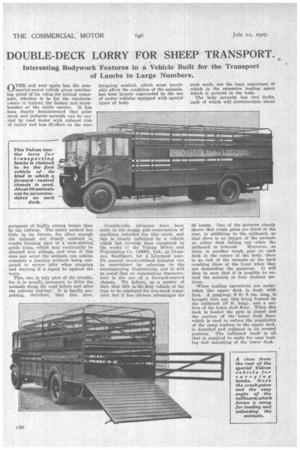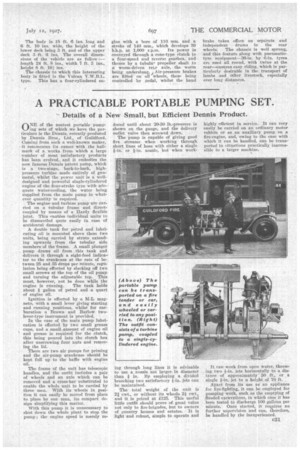DOUBLE-DECK LORRY FOR SHEEP TRANSPORT.
Page 52

Page 53

If you've noticed an error in this article please click here to report it so we can fix it.
Interesting Bodywork Features in a Vehicle Built for the Transport of Lambs in Large Numbers, OVER and over again has the commercial-motor vehicle given convincing proof of its value for animal transport, whether it be for the racehorse owner or trainer, the farmer and stockbreeder or the cattle carrier. It has been clearly demonstrated that prize stock and pedigree animals can be carried by road motor with reduced risk of injury and less ill-effect on the tern perament of highly Strung beasts than by the railway. The latter method has little in its favour, for often enough the animals are closely confined is trucks forming part Of a slow-moving. goods train, which may continually be shunted into sidings, and even if this does not occur the animals can seldom complete a journey without being subjected to severe jolts when stopping and starting if a signal be against the train.
This, too, is. only part of the trouble, for it is usually, necessary to drive the animals along the road before and after the railway journey. It is hardly surprising, therefore, that this slow, fatiguing method, which must inevitably affect the condition of the animals, has been largely superseded by the use of motor vehicles equipped with special types of body.
Considerable advances have been made in the design and construction of machines intended for this work, and this is clearly indicated by a vehicle which has recently been completed in the works or the Vulcan Motor and Engineering Co. (1906), Ltd., at Crossens, Southport, for a Liverpool user. .Its general constructional features can be ascertained by referring to the accompanying illustrations, and it will be noted that an outstanding characteristic is the use of a forward-control chassis. We believe, as a matter of fact, that this is the first vehicle of the type to be employed for live-stock transport, but it has obvious advantages for
such work, not the least important of which is the extensive loading space which it permits in the body.
The body actually has two decks, each of which will accommodate about 80 lambs. One of the pictures clearly shows that crush gates are fitted at the rear, in adddition to the tailboard, so that there is no danger of the animals on either deck falling out when the
tailboard is lowered. Moreover, as there is another crush gate to each deck in the centre of the body, there is no risk of the animals at the back crushing those at the front when they are descending the gangway. It will thus be seen that it is possible to unload the animals in four distinct sec tions.
When loading operations are undertaken the upper deck is dealt with first. A gangway, 9 ft. 6 ins, long, is brought into use, this being formed by the tailboard (6 ft. long) and a section of the lower deck floor. When this deck is loaded the gate is closed and the portion of the' lower deck floor, which is used to reduce the angularity of the ramp leading to the upper deck, is detached and replaced in its normal position. The tailboard itself is all that is required to make for easy loading and unloading of the lower deck.
The body is IS ft 6 ins, long and 6 ft. 10 ins, wide, the height of the lower deck being 2 ft. and of the upper deck 3 ft. 6 ins.. The overall dimensions of the vehicle are as follow :— length 24 ft. S ins., width 7 ft. 3 ins., height 8 ft. 113L: ins.
The chassis to which this interesting body is fitted is the Vulcan V.W.B.L. type. This has a four-cylindered en
gine with a bore of 110 rpm. and a stroke of 140 mm., which develops 39 b.h.p. at 1,000 r.p.m. Its power is conveyed through a cone-type clutch to a four-speed and reversa gearkx, and thence by a tubulapropeller shaft to a worm-driven reLr axle, the worm being underslung.Air-pressure brakes are fitted on all wheels, these being controlled by pedal, whilst the hand brake takes effect on sepsrate and independent drums in the rear wheels. The chassis is well sprung, and this feature along with pneumatictyre equipment--36-in. by 6-in. tyres am used all round, with twins at the rear—ensures easy riding, which is particularly desirable in the transport of lambs and Other livestock, especially over long distances.












































































































